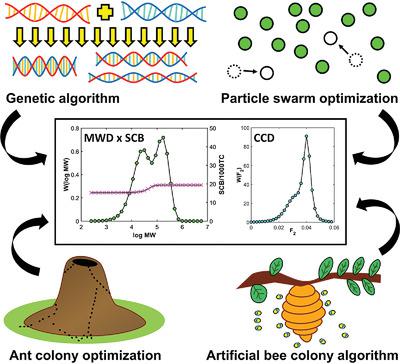当前位置:
X-MOL 学术
›
Macromol. Theor. Simul.
›
论文详情
Our official English website, www.x-mol.net, welcomes your
feedback! (Note: you will need to create a separate account there.)
Using Artificial Intelligence Techniques to Design Ethylene/1‐Olefin Copolymers
Macromolecular Theory and Simulations ( IF 1.8 ) Pub Date : 2020-07-30 , DOI: 10.1002/mats.202000048 Thanutchoke Charoenpanich 1 , Siripon Anantawaraskul 1, 2 , João B. P. Soares 3
Macromolecular Theory and Simulations ( IF 1.8 ) Pub Date : 2020-07-30 , DOI: 10.1002/mats.202000048 Thanutchoke Charoenpanich 1 , Siripon Anantawaraskul 1, 2 , João B. P. Soares 3
Affiliation

|
Four global optimization techniques, genetic algorithm, particle swarm, improved ant colony, and modified artificial bee colony, are compared to find alternative polymerization conditions to make ethylene/1‐olefin copolymers with targeted microstructures and polymerization yields. The polymer microstructure targets are divided in three groups: 1) molecular weight distribution, chemical composition distribution, and polymer yield; 2) number and weight average molecular weights, average comonomer content, and polymer yield; and 3) molecular weight distribution, short chain branching distribution, and polymer yield. The modified artificial bee colony optimization generated the fewest number of incorrect solutions, while the polymer microstructure target group 1 generated the most successful solutions.
中文翻译:

使用人工智能技术设计乙烯/ 1-烯烃共聚物
比较了四种全局优化技术,遗传算法,粒子群,改进的蚁群和改良的人工蜂群,以找到替代的聚合条件,以制备具有目标微结构和聚合产率的乙烯/ 1-烯烃共聚物。聚合物的微观结构目标分为三组:1)分子量分布,化学组成分布和聚合物产率;2)数均和重均分子量,平均共聚单体含量和聚合物产率;3)分子量分布,短链支化分布和聚合物产率。改进的人工蜂群优化产生了最少数量的错误解决方案,而聚合物微结构目标群1产生了最成功的解决方案。
更新日期:2020-07-30
中文翻译:

使用人工智能技术设计乙烯/ 1-烯烃共聚物
比较了四种全局优化技术,遗传算法,粒子群,改进的蚁群和改良的人工蜂群,以找到替代的聚合条件,以制备具有目标微结构和聚合产率的乙烯/ 1-烯烃共聚物。聚合物的微观结构目标分为三组:1)分子量分布,化学组成分布和聚合物产率;2)数均和重均分子量,平均共聚单体含量和聚合物产率;3)分子量分布,短链支化分布和聚合物产率。改进的人工蜂群优化产生了最少数量的错误解决方案,而聚合物微结构目标群1产生了最成功的解决方案。











































 京公网安备 11010802027423号
京公网安备 11010802027423号